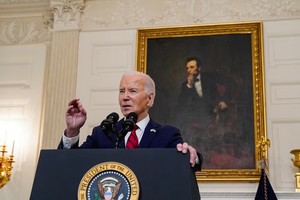When John Roberts and Bill Clinton Join Forces

When President Bill Clinton was seeking re-election in 1996, he navigated a complicated political debate over affirmative action with the pithy phrase, “Mend it, but don’t end it.” These adroit linguistic gymnastics allowed Clinton to oppose a California ballot initiative that prohibited the use of racial preferences in college admissions and government hiring without offering a specific alternative.
More than a quarter-century later, Supreme Court Chief Justice John Roberts has now finished the job.
When the Court decided late last month that race-based preferences violated the equal protection clause of the Civil Rights Act and the 14th Amendment to the U.S. Constitution, the highly charged reactions from both defenders and critics of the current system suggested that a major overhaul of college admissions policy had taken place. But in actuality, there was much less to their ruling than meets the eye. A candidate’s racial or ethnic status will still play a major role in determining which students will be welcomed into a competitive college or university of their choice, even if the discussion leading up to these decisions will be configured somewhat differently.
Make no mistake, affirmative action is dead, at least as it has traditionally been defined. An applicant to an institute of higher learning can no longer be asked to provide their race or ethnicity, and colleges and universities can no longer include such demographic characteristics as a contributing factor in their admissions decisions. But Roberts’ majority opinion also created an immense loophole—intentionally or otherwise—making it clear that the way a student’s life experience and perspective have been shaped by their racial or ethnic identity should still be a critical part of the admissions process.
Read Roberts’ own words:
Nothing in this opinion should be construed as prohibiting universities from considering an applicant’s discussion of how race affected his or her life, be it through discrimination, inspiration, or otherwise.
The chief justice has not only provided a roadmap for applicants to discuss their racial or ethnic makeup in the context of how it has shaped their character, beliefs and attitudes, but he has also issued a warning directed at those who would try to completely prohibit the consideration of these demographic characteristics as part of admissions decisions. But Roberts then continues, providing even more specific instructions on how these questions should be handled:
A benefit to a student who overcame racial discrimination, for example, must be tied to that student’s courage and determination. Or a benefit to a student whose heritage or culture motivated him or her to assume a leadership role or attain a particular goal must be tied to that student’s unique ability to contribute to the university. In other words, the student must be treated based on his or her experiences as an individual — not on the basis of race.
Roberts appears to have crafted a compromise that both sides of the debate should appreciate. He has managed to achieve a tangible fulfillment of Clinton’s vague exhortation that both prioritizes the individual over the classification while still acknowledging the continued impact of racial discrimination in American society. The distinction between someone’s racial or ethnic heritage and how that heritage has shaped them as a human being is critical in that it reconciles two laudable but seemingly contradictory objectives.
The end result is neither a radical reversal nor a hidebound reinforcement of a status quo that was instituted almost sixty years ago. Rather, it is an evolution that builds on important principles but adapts to a new political and societal landscape. Going forward, smart young women and men desiring to attend an elite university will still have the opportunity to present their qualifications in a way that rewards their diversity in the name of creating a richer and more diverse campus environment.
The opportunity exists to create academic communities comprised of students who not only look different from each other, but think, act and feel differently too. Since California’s ban on affirmative action in 1996, the university system here has employed other forms of outreach to dramatically increase the number of minority students on its campuses. Whether or not Roberts meant to do so, he has provided a tool that will make it more likely that such growth will continue in all fifty states. His opinion certainly represents change, but in this case at least, the Court is mending, not ending.
Want to talk about this topic more? Join Dan for his webinar "Politics In The Time of Coronavirus." Or read more of Dan’s writing at: www.danschnurpolitics.com.
Dan Schnur is a Professor at the University of California – Berkeley, Pepperdine University, and the University of Southern California, where he teaches courses in politics, communications and leadership. Dan is a No Party Preference voter, but previously worked on four presidential and three gubernatorial campaigns, serving as the national Director of Communications for the 2000 presidential campaign of U.S. Senator John McCain and the chief media spokesman for California Governor Pete Wilson. He has a Center bias.
This piece was reviewed and edited by Isaiah Anthony, Deputy Blog Editor (Center bias).
“South to America” by Imani Perry
Dock C. Bracy Center for Human Reconciliation
May 22 at 4pm PT / 7pm ET
Resetting the Table: Wisdom from Conflict
The Village Square
May 22 at 9pm PT / 12am ET
The White Power Movement: Its History, Threat and…
Dock C. Bracy Center for Human Reconciliation
September 18 at 4pm PT / 7pm ET

May 2nd, 2024

May 1st, 2024

May 1st, 2024

April 29th, 2024